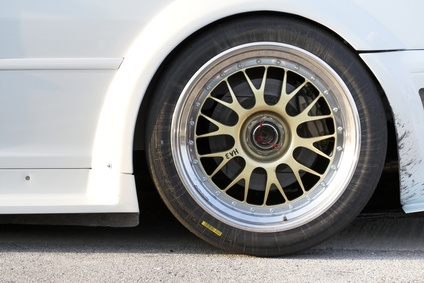
There is a dizzying array of rims available for just about every car and truck ever made. But obviously not every wheel will go on every vehicle. Wheels are made with a specific vehicle in mind and are designed with a particular dimension, bolt pattern and offset. Telling the difference between different types of wheels is relatively easy with the right knowledge.
Inspect the center cap, rim and back of the wheel for any manufacturer markings to determine who made the wheel. Wheel makers generally put their logo on the center cap of the wheel. If there is not center cap or no markings on the center cap, then look on the lip and the face--or center part--of the wheel for markings. You can also turn the wheel over and look at the back of the wheel for any distinctive markings.
Study the wheel itself to determine if it is a steel wheel or an alloy. Most cars come with some type of alloy wheel, but steel wheels are still widely used. A steel will generally be heavier than an alloy wheel if you pick up one of each. Steel wheels also are generally more plain looking than alloys because they are stamped rather than cast or forged. While alloys usually feature a spoke or mesh design of some type, steel wheels have round or rectangular holes in them.
Measure the offset of the wheel to determine if it is a positive offset wheel or a negative offset wheel. The offset is the measurement from the centerline of the wheel to the hub mounting surface of the wheel. If the hub mounting surface of the wheel is between the center line of the wheel and the inside edge of the wheel, then it is negative offset wheel and will protrude from the suspension more. If the hub mounting surface is between the center line of the wheel and the outer edge of the wheel it is a positive offset wheel.
Front wheel drive cars and some modern rear wheel drive cars use positive offset wheels. Negative offset wheels are often used on rear wheel drive muscle cars and sports cars.
Determine the dimensions and the bolt pattern of the wheel. To determine the diameter of the wheel measure the distance across the face of the wheel. The measurement will be anywhere from 13 inches to 20 inches and occasionally larger. The width is determined by measuring the distance between the inside lip of the face of the wheel to the inside lip of the inner side of the wheel. This will be anywhere from 4 inches to 12 inches or wider.
To determine the bolt pattern, count the number of holes there are for lug nuts and then measure the distance from one lug nut to the one directly, or as close to directly, across from it. The measurement will be something like 4x100, which means four lug holes that are 100 mm across from each other.